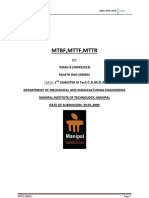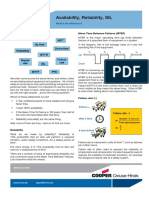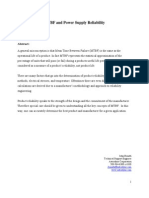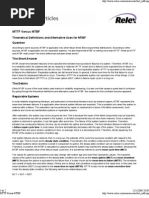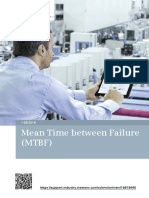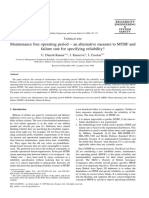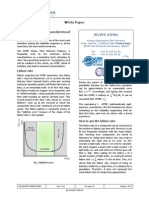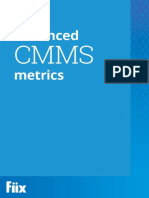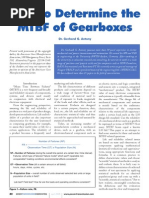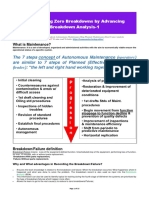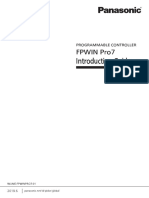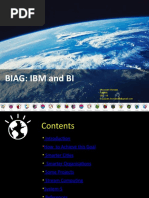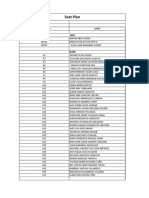MTBF MTTR MTTF FIT Terms 3618wp 1703446671
MTBF MTTR MTTF FIT Terms 3618wp 1703446671
Uploaded by
Dan SartoriCopyright:
Available Formats
MTBF MTTR MTTF FIT Terms 3618wp 1703446671
MTBF MTTR MTTF FIT Terms 3618wp 1703446671
Uploaded by
Dan SartoriOriginal Title
Copyright
Available Formats
Share this document
Did you find this document useful?
Is this content inappropriate?
Copyright:
Available Formats
MTBF MTTR MTTF FIT Terms 3618wp 1703446671
MTBF MTTR MTTF FIT Terms 3618wp 1703446671
Uploaded by
Dan SartoriCopyright:
Available Formats
WHITE PAPER
MTBF, MTTR, MTTF, FIT MTBF remains the basic measure of a system’s
EXPLANATION OF TERMS reliability for most products...a useful tool when
evaluating a product purchase.
MTBF, but consumers are often price driven. They may not realize
Purpose that a product with a short lifespan really is not much of a bargain.
The intent of this White Paper is to provide an understanding
of MTBF and other product reliability methods. Understanding
MTBF data is not always readily available but, it is worth asking
the methods for the lifecycle prediction for a product enables
for the information. MTBF data should be a required line item
the customer to consider the tangible value of the product
in a request-for-quote (RFQ). If this data is not provided, a
beyond set-features before purchasing it.
manufacturer’s piece of equipment should be immediately
disqualified.
MTBF, MTTR, MTTF and FIT are reliability terms based on
methods and procedures for product lifecycle predictions.
Mean Time To Repair (MTTR) is the mean time needed to repair
Customers must often include reliability data when specifying
a failed hardware module. The actual installation time is only part
what product to buy for their application. MTBF (Mean Time
of the story. The time required to acquire the new part is also a
Between Failure), MTTR (Mean Time To Repair), MTTF (Mean
factor. Down-time costs money.
Time To Failure) and FIT (Failure In Time) are ways of providing
a numeric value based on a compilation of data to quantify a
Mean Time To Failure (MTTF) is a measure of reliability for non-
failure rate and the resulting time of expected performance.
repairable systems. It is the mean time expected until the piece
The numeric value can be expressed using any measure of
of equipment fails and needs to be replaced. MTTF is a statistical
time, but hours is the most common unit in practice.
value and is calculated as the mean over a long period of time
and a large number of units. MTBF should be used in reference to
repairable items, while MTTF should be used for non-repairable
items. However, MTBF is commonly used for both repairable and
non-repairable items.
Failure In Time (FIT) is another way of reporting MTBF. FIT reports
the number of expected failures per one billion hours of operation
for a device. This term is very important in the semiconductor
industry, but is also used by component manufacturers. FIT
can be quantified in a number of ways. Examples include: 1000
devices for 1 million hours, 1 million devices for 1000 hours each,
and other similar combinations. FIT and Comfidence Limits (CL)
Definitions are often provided together. In common usage, a claim to 95%
Product purchasing decisions should not be based on confidence in something is normally taken as indicating virtual
feature sets alone. You should also consider the product’s life certainty. In statistics, a claim to 95% confidence simply means that
expectancy. Understanding the methods used to predict a the researcher has seen something occur that only happens one
product life cycle will help you make informed decisions. time in twenty, or less. For example, component manufacturers
will take a small sampling of a component, test for x number of
Mean Time Between Failure (MTBF) is the number of hours, and then determine if there were any failures in the test
failures per million hours for a product. This is the most bed. The CL will be based on the number of failures that occurred.
common parameter used to predict a product’s life span.
Industries and integrators tend to pay close attention to
WHITE PAPER
Using MTBF Data
The MTBF is often calculated based on an algorithm that factors improvement” and “zero defects”. That means that a product will
in all of a product’s components to reach the sum life cycle in be rigorously tested in numerous ways, including submissions to
hours. This calculation assumes that the product was properly outside labs for the appropriate certifications. The product is far
packaged when delivered, that it was installed correctly, and that more likely to be as flawless and as functional as advertised.
the customer is not doing anything to damage the product after it
has been deployed. A product with an extremely high MTBF may Reliability methods such as MTTR, MTTF and FIT apply to products
not necessarily have an equally impressive service life, depending or to specific components. However, MTBF remains the basic
upon how it is being treated. measure of a system’s reliability for most products. The true value
of MTBF calculations is often debated, sometimes called irrelevant
and often misunderstood. But, it is still a very useful tool when
evaluating a product purchase. Always ask for an MTBF value,
always find out how current that information is and always find
out what standards it is based upon. That will help you choose
wisely, and to select the appropriate product for your application.
MTBF is more than a simple formula. A person certified and Reliability Methods & Standards
educated in calculating MTBF must review the MTBF for every Numerous prediction methods have been developed to determine
component, as well as other factors like operating temperature reliability. For example, the most common standards for media
range and storage temperature range. converters are the MIL-HDBK- 217F Notice 2 (Military Handbook
published by the Department of Defense) and the Bellcore TR332,
In addition to the MTBF calculation, quality assurance managers (used by most commercial electronic product companies).
should track all reported field failures as well as the root causes.
Combining all of this data should produce a more accurate The MIL-HDBK- 217F Notice 2 predicts reliability with two
prediction of a product’s service life. Since this process takes time, methods: Parts Count Prediction (used to predict the reliability of
calculating the MTBF and other predictions of reliability is an on- a product in its early development cycle) and Parts Stress Analysis
going process. Prediction (used later in the development cycle, as the product
nears production).
MTBF can be subject to change. For example, RoHS “(Restriction
of Hazardous Substances”) was mandated by the European Bellcore TR332 uses the MIL-HDBK- 217F Notice 2 as a starting
Community in 2006. If a released product is re-developed in point, but modifies – and simplifies – the models to better reflect
order to meet RoHS compliance, the entire calculation has to be
Bellcore’s field experience.
performed again. New, RoHS-compliant components may have a
different life cycle than the parts that they replace.
ISO-9001 Certification is an indication that the manufacturer
has calculated the MTBF accurately. ISO certified companies
have committed themselves to meet the goals of “continual
Enabling An Intelligent Planet
Worldwide Headquarters US Corporate Headquarters Cellular Product Group OEM & Product Modification
Taiwan 707 Dayton Road Sokolská 71, 562 04 Ústí nad Orlicí Ill. Phone: 815-433-5222
ADVANTECH Ottawa, IL 61350 USA Czech Republic Fax: 815-433-5104
No. 1, Alley 20, Lane 26, Rueiguang Road, Phone: 1-815-433-5100 Phone: +420 465 521 020 Attn: Custom Dept.
Neihu District, Taipei 11491, Taiwan, R.O.C. Fax: 1-815-433-5109 Fax: +420 464 647 299 custom@advantech-bb.com
Toll Free: 0800-777-111 orders@advantech-bb.com GSM: +420 603 872 287 Custom Quote Request Form:
www.advantech.com www.advantech-bb.com cellularsales@advantech-bb.com www.advantech-bb.com/custom
European Headquarters Middle East, UAE, Africa Latin America, Caribbean
10 Westlink Commercial Park
Oranmore, Co. Galway, Ireland
AG Silver Tower, JLT, P.O. Box 48777
Dubai, UAE
Phone: 1-727-797-0300
Cell: 1-727-480-5920
advantech-bb.com
Phone: +353 91 792444 Mobile: +971 50 943 65 62 latamsales@advantech-bb.com
Fax: +353 91 792445 mdeast-afrsales@advantech-bb.com 3618
eSales@advantech-bb.com
You might also like
- Tutorial#11 - GUI ModellingDocument4 pagesTutorial#11 - GUI ModellingAmna QayyumNo ratings yet
- KTU B Tech Project Report Template-1Document29 pagesKTU B Tech Project Report Template-1Adarsh Lenin100% (1)
- Product Reliability and MTBF2Document4 pagesProduct Reliability and MTBF2sifuszNo ratings yet
- Advanced CMMS Metrics (KPI)Document18 pagesAdvanced CMMS Metrics (KPI)ambuenaflor100% (1)
- 3162.Mtbf MTTF MTTR Fit ExplanationsDocument3 pages3162.Mtbf MTTF MTTR Fit ExplanationsGeorgeSalazarNo ratings yet
- MTBF MTTR MTTF FitDocument4 pagesMTBF MTTR MTTF Fitamitverma7737458138No ratings yet
- Q & A ReliablityDocument6 pagesQ & A ReliablitypkcdubNo ratings yet
- Mean Time Between FailureDocument10 pagesMean Time Between FailureJay Rai100% (1)
- What Is MTBFDocument2 pagesWhat Is MTBFElvis DiazNo ratings yet
- Crouse Hinds MTL Availability Reliability Sil Application NoteDocument3 pagesCrouse Hinds MTL Availability Reliability Sil Application Notesiddhant103No ratings yet
- Time To Move On From Mean Time Between Failure (MTBF) and Mean Time To Failure (MTTF)Document4 pagesTime To Move On From Mean Time Between Failure (MTBF) and Mean Time To Failure (MTTF)aliNo ratings yet
- MTBFDocument5 pagesMTBFRohith KumarNo ratings yet
- MTTR & MTBFDocument7 pagesMTTR & MTBFgear profile dewasNo ratings yet
- Availability, Reliability, SIL: Mean Time Between Failures (MTBF)Document4 pagesAvailability, Reliability, SIL: Mean Time Between Failures (MTBF)BenNo ratings yet
- Simple Guide To MTBFDocument14 pagesSimple Guide To MTBFAminu A.ONo ratings yet
- MTBF and Power Supply ReliabilityDocument8 pagesMTBF and Power Supply ReliabilityMazlan MansorNo ratings yet
- MTBFDocument4 pagesMTBFmithileshkumareicNo ratings yet
- Time To Move On From MTBFDocument5 pagesTime To Move On From MTBFElvis DiazNo ratings yet
- Unit 1Document10 pagesUnit 1Shaku SinglaNo ratings yet
- Mean Time Between FailureDocument10 pagesMean Time Between FailureMansour Soliman50% (2)
- MTBF MTTF and MTTR 1710550424Document4 pagesMTBF MTTF and MTTR 1710550424Shaukat NadeemNo ratings yet
- Availability, Reliability, SIL: Mean Time Between Failures (MTBF)Document4 pagesAvailability, Reliability, SIL: Mean Time Between Failures (MTBF)최재호No ratings yet
- Countering Technical Failures in Delhi Metro Using DataDocument15 pagesCountering Technical Failures in Delhi Metro Using DataMohit KumarNo ratings yet
- Mean Time Between Failures - Wikipedia, The Free EncyclopediaDocument3 pagesMean Time Between Failures - Wikipedia, The Free EncyclopediaXin LiNo ratings yet
- Mech Eng ReliabilityDocument3 pagesMech Eng ReliabilityAjay MayalNo ratings yet
- Performing Effective MTBF Comparisons For Data Center InfrastructureDocument16 pagesPerforming Effective MTBF Comparisons For Data Center Infrastructure(unknown)No ratings yet
- MTTR MTBF - Simple GuideDocument10 pagesMTTR MTBF - Simple Guidenadal.shahidNo ratings yet
- Availability, Reliability, SILDocument3 pagesAvailability, Reliability, SILGeorgina SuleNo ratings yet
- 8 Essential KPIs For Maintenance Management - TRACTIANDocument26 pages8 Essential KPIs For Maintenance Management - TRACTIANsatya krishna chaganti100% (1)
- How Can You Measure The Success of TPM Implementation in ManufacturingDocument8 pagesHow Can You Measure The Success of TPM Implementation in ManufacturingjvanandhNo ratings yet
- Difference Between Availability, Reliability & SILDocument7 pagesDifference Between Availability, Reliability & SILchetan devikarNo ratings yet
- MTTF Versus MTBFDocument2 pagesMTTF Versus MTBFMeder Peralta DavilaNo ratings yet
- MTBF Complete Overview - Reliable Plant - 201911Document6 pagesMTBF Complete Overview - Reliable Plant - 201911luchoamixNo ratings yet
- MTBF enDocument5 pagesMTBF enBooster HidroNo ratings yet
- Maintenance Free Operating Period - An Alternative Measure To MTBF and Failure Rate For Specifying Reliability - ElsevierDocument5 pagesMaintenance Free Operating Period - An Alternative Measure To MTBF and Failure Rate For Specifying Reliability - ElsevierGyogi MitsutaNo ratings yet
- Maintenance EbookDocument9 pagesMaintenance EbookAhmed IbrahimNo ratings yet
- White Paper MTBF: The Most Misunderstood RAMS Parameter: Silver AtenaDocument2 pagesWhite Paper MTBF: The Most Misunderstood RAMS Parameter: Silver AtenaJuan Ramón RuizNo ratings yet
- TPM 2Document54 pagesTPM 2TIAGO COSTANo ratings yet
- Unit 9 Reliability, Availability and Maintainability ConceptsDocument10 pagesUnit 9 Reliability, Availability and Maintainability ConceptsirasnaNo ratings yet
- An Introduction To Total Productive Maintenance (TPM)Document21 pagesAn Introduction To Total Productive Maintenance (TPM)praveenchinnaNo ratings yet
- Finalppt 131229010307 Phpapp02Document102 pagesFinalppt 131229010307 Phpapp02Georgina SuleNo ratings yet
- Maintenance Kpi Work SheetDocument4 pagesMaintenance Kpi Work SheetBenson KhamalaNo ratings yet
- Honeywell Webinar QA Is Your PID Controller Performance Up To ParDocument4 pagesHoneywell Webinar QA Is Your PID Controller Performance Up To PartsipornNo ratings yet
- Advanced CMMS MetricsDocument17 pagesAdvanced CMMS Metricscderin2000No ratings yet
- MTBF and Availability PrimerDocument5 pagesMTBF and Availability PrimerSatyanneshi ERNo ratings yet
- ParkerDocument10 pagesParkerBety MuluNo ratings yet
- ME2037 Maintenance EngineeringDocument51 pagesME2037 Maintenance EngineeringVicky Vignesh100% (1)
- Maintenance StrategyDocument15 pagesMaintenance StrategyChitta RoutNo ratings yet
- SKF Bearing ReliabilityDocument14 pagesSKF Bearing Reliabilityedimazor100% (1)
- PIFC in Heat Treatment and Machining LineDocument8 pagesPIFC in Heat Treatment and Machining LineMansita SimbolonNo ratings yet
- Solution Manual Managerial Accounting Chapter 14Document4 pagesSolution Manual Managerial Accounting Chapter 14ukandi rukmanaNo ratings yet
- 0510 Performance Metrics For Mining EquipmentDocument64 pages0510 Performance Metrics For Mining EquipmentLorenzoNoePerezRodriguez80% (5)
- ME2037 - Maintenance Engineering (Eighth Semester Mech) Question BankDocument20 pagesME2037 - Maintenance Engineering (Eighth Semester Mech) Question BankSK NAGOOR VALINo ratings yet
- Introduction To Operational AvailabilityDocument10 pagesIntroduction To Operational AvailabilityTUSA BESQUI ENSOYNo ratings yet
- Me 1019Document45 pagesMe 1019rkumaravelan4137No ratings yet
- Antony How To Determine The MTBF of GearboxesDocument6 pagesAntony How To Determine The MTBF of GearboxesSid RcNo ratings yet
- Logistics Repairables Consumables: RepairableDocument2 pagesLogistics Repairables Consumables: RepairableAnanthu VijayakumarNo ratings yet
- Lean-based Production Management: Practical Lean ManufacturingFrom EverandLean-based Production Management: Practical Lean ManufacturingNo ratings yet
- How to Create Continuous Production Flow?: Toyota Production System ConceptsFrom EverandHow to Create Continuous Production Flow?: Toyota Production System ConceptsRating: 5 out of 5 stars5/5 (1)
- Reliability Engineering Reducing Risk Product Development 1694651338Document40 pagesReliability Engineering Reducing Risk Product Development 1694651338Dan SartoriNo ratings yet
- Strategic Maintenance Development 1693341672Document74 pagesStrategic Maintenance Development 1693341672Dan SartoriNo ratings yet
- Spare Parts Control 1694518419Document24 pagesSpare Parts Control 1694518419Dan SartoriNo ratings yet
- Tool Box Talk Preventive Maintenance 105 Operator Care 1597205124Document1 pageTool Box Talk Preventive Maintenance 105 Operator Care 1597205124Dan SartoriNo ratings yet
- Maintenance Function's Performance Evaluation Using Adapted Balanced Scorecard ModelDocument5 pagesMaintenance Function's Performance Evaluation Using Adapted Balanced Scorecard ModelDan SartoriNo ratings yet
- Maintenance Planning and Scheduling 1601071320Document7 pagesMaintenance Planning and Scheduling 1601071320Dan SartoriNo ratings yet
- Approaching Zero Breakdowns by Advancing Breakdown Analysis-1Document15 pagesApproaching Zero Breakdowns by Advancing Breakdown Analysis-1Dan Sartori100% (1)
- Strategic Asset Management Plan 2021 22Document46 pagesStrategic Asset Management Plan 2021 22Dan SartoriNo ratings yet
- Inplant Training ReportDocument7 pagesInplant Training ReportGuruprasad S HegdeNo ratings yet
- Botium Toys - Scope, Goals, and Risk Assessment ReportDocument3 pagesBotium Toys - Scope, Goals, and Risk Assessment Reportxxidentity.xx.admNo ratings yet
- ProgressDocument1,024 pagesProgresskurlanNo ratings yet
- MN Fpwinpro7 Guide Pidsx en PDFDocument174 pagesMN Fpwinpro7 Guide Pidsx en PDFPetio MineffNo ratings yet
- Workshop 3.dii1109Document8 pagesWorkshop 3.dii1109Diego OrellanaNo ratings yet
- HC900 Controller SpecificationDocument26 pagesHC900 Controller SpecificationHTV AT ChannelNo ratings yet
- Dissertation Poesie ExempleDocument4 pagesDissertation Poesie ExemplePaperWritersSingapore100% (1)
- Differences Between Classes and Interfaces, Implementing InterfacesDocument35 pagesDifferences Between Classes and Interfaces, Implementing InterfacesGanesh NelluriNo ratings yet
- Fnci Oss Third PartyDocument3 pagesFnci Oss Third PartyIsro' fajar roslinaNo ratings yet
- 24 Implementing Lists, Stacks, Queues, and Priority QueuesDocument40 pages24 Implementing Lists, Stacks, Queues, and Priority QueuesihhuamkudnqtkqeitnNo ratings yet
- Microsoft Competency GuideDocument34 pagesMicrosoft Competency GuidefakhritNo ratings yet
- Open Source IoT Based SCADA System For RDocument5 pagesOpen Source IoT Based SCADA System For RelmoustaphaelNo ratings yet
- UtilDocument64 pagesUtilalexandrNo ratings yet
- Scaling Memcache at Facebook - SlidesDocument28 pagesScaling Memcache at Facebook - SlidesgamezzzzNo ratings yet
- Immediate download Problem Solving in Data Structures Algorithms Using C Programming Interview Guide 1st Edition Hemant Jain ebooks 2024Document55 pagesImmediate download Problem Solving in Data Structures Algorithms Using C Programming Interview Guide 1st Edition Hemant Jain ebooks 2024helalbunnyil100% (1)
- Sol Trigger NPJH-50619Document6 pagesSol Trigger NPJH-50619Kiki RamaNo ratings yet
- Docker Commands Kubernetes Architecture: Don't Forget!Document1 pageDocker Commands Kubernetes Architecture: Don't Forget!Mohit SharmaNo ratings yet
- Biag: Ibm and Bi: Mouzzam Hussain Fuiems CSC - ViiDocument40 pagesBiag: Ibm and Bi: Mouzzam Hussain Fuiems CSC - ViiMouzzam HussainNo ratings yet
- Sudo Vs Su - The Difference Between Sudo and Su ExplainedDocument10 pagesSudo Vs Su - The Difference Between Sudo and Su Explainedshivsagar05No ratings yet
- COURSE Project (25%) : Electromechanical Motion Devices EE 321Document9 pagesCOURSE Project (25%) : Electromechanical Motion Devices EE 321Shehab AshrafNo ratings yet
- Cyber Incident Response and Planning: A Flexible Approach: FeatureDocument6 pagesCyber Incident Response and Planning: A Flexible Approach: FeatureSenait MebrahtuNo ratings yet
- Esc Configurator LogDocument2 pagesEsc Configurator Loghassan.ali14741No ratings yet
- Lenovo System x3650 M4 HD Installation and Service Guide: Machine Type: 5460Document1,168 pagesLenovo System x3650 M4 HD Installation and Service Guide: Machine Type: 5460OperadorNo ratings yet
- Seat PlanDocument7 pagesSeat PlanChristopher ApaapNo ratings yet
- Cabbash POS Proposal IIIDocument11 pagesCabbash POS Proposal IIIOghosa OsahenrhumwenNo ratings yet
- Chapter 4 - Data Base Manipulation Using PHPDocument23 pagesChapter 4 - Data Base Manipulation Using PHPmenber228No ratings yet
- Final Demo Lesson PlanDocument5 pagesFinal Demo Lesson PlanJhon Edward Señor100% (1)
- Excel Manual-Part 1Document53 pagesExcel Manual-Part 1msrhsrhNo ratings yet







